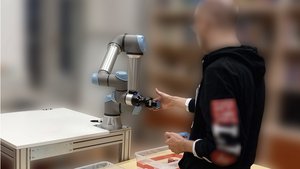Publications
Selected Publications
This page shows selected publications from the last years. For a detailed list please refer to the Google Scholar or DBLP page of Stefan Schneegass.

Type of Publication: Article in Collected Edition
Push Me: Evaluating Usability and User Experience in Nudge-based Human-Robot Interaction through Embedded Force and Torque Sensors
- Author(s):
- Kassem, Khaled; Saad, Alia; Pascher, Max; Schett, Martin; Michahelles, Florian
- Title of Anthology:
- Proceedings of Mensch Und Computer 2024
- pages:
- 399-407
- Publisher:
- Association for Computing Machinery
- Location(s):
- New York, NY, USA
- Publication Date:
- 2024
- ISBN:
- 9798400709982
- Digital Object Identifier (DOI):
- doi:10.1145/3670653.3677487
- Fulltext:
- <a href="/fileadmin/fileupload/I-HCI/muc24b-sub1121-cam-i19.pdf" class="pdf">Push Me: Evaluating Usability and User Experience in Nudge-based Human-Robot Interaction through Embedded Force and Torque Sensors (8.18 MB)</a>
- Link to complete version:
- https://dl.acm.org/doi/10.1145/3670653.3677487
- Citation:
- Download BibTeX
Abstract
Robots are expected to be integrated into human workspaces, which makes the development of effective and intuitive interaction crucial. While vision- and speech-based robot interfaces have been well studied, direct physical interaction has been less explored. However, HCI research has shown that direct manipulation interfaces provide more intuitive and satisfying user experiences, compared to other interaction modes. This work examines how built-in force/torque sensors in robots can facilitate direct manipulation through nudge-based interactions. We conducted a user study (N = 23) to compare this haptic approach with traditional touchscreen interfaces, focusing on workload, user experience, and usability. Our results show that haptic interactions are more engaging and intuitive but also more physically demanding compared to touchscreen interaction. These findings have implications for the design of physical human-robot interaction interfaces. Given the benefits of physical interaction highlighted in our study, we recommend that designers incorporate this interaction method for human-robot interaction, especially at close quarters.
